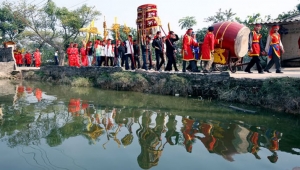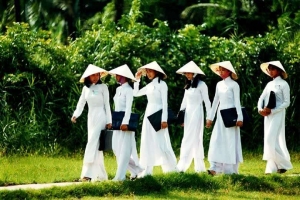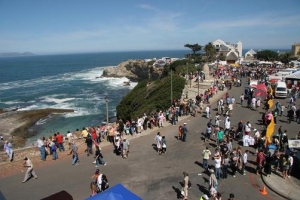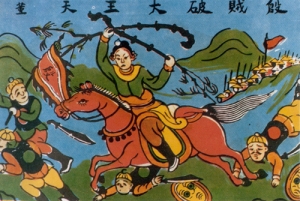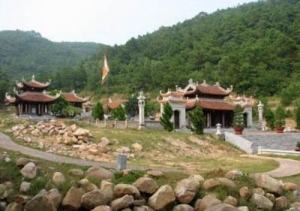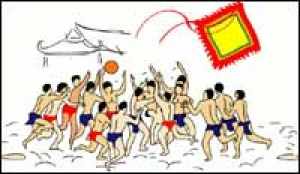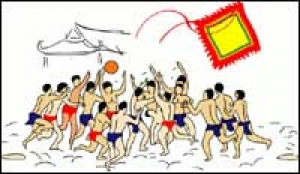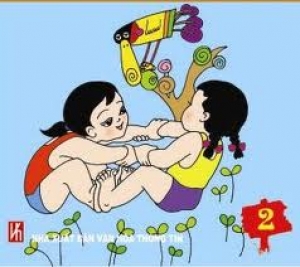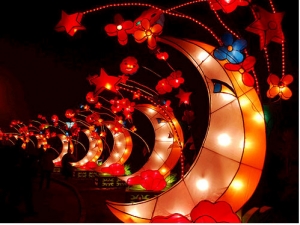
Asia Pacific Travel Team
“Summer’s Cubes”, the Fiesta for Children at Hue Festival 2010
Children, with their innocent minds. Children, with their innocent minds and spontaneous imagination, can always create their own cute and astonishing world. With only a few discarded carton boxes, some paints and self-made tools, a group of children can make for themselves such an interesting and charming playground that surprises any adult and provokes the desire how to come back our childhood for just a moment to be immersed in that simple but colorful world and enjoy happy feelings of a better life from children’s perspective.
The fiesta themed“Summer’s Cubes” at Hue Festival 2010 will help us to rediscover part of children’s diverse world through a “square kaleidoscope” which magically transform everything in our daily life into a vibrant cubic party...
The Breath of Water
Hue’s Nha Nhac (Royal Music), Ca tru and Quan Ho - the three UNESCO intangible heritage values will be showcas. Hue’s Nha Nhac (Royal Music), Ca tru and Quan Ho - the three UNESCO intangible heritage values will be showcased together with other traditional artforms like “Cheo”, poem recitation, folk songs in a very special performance entitled “The Breath of Water”.
The performance depicts the love story of a young couple. A beautiful and charming girl coming from the North was recruited to be an imperial maid for the royal family. During her long and lonely boat trip to the imperial city, she agonizingly recalled the happy moments with her sweatheart. The surface of Tinh Tam Lake is like a mirror for the the girl’s memories of the past. Besides the purpose of honouring cultural heritages, “The Breath of Water” will also praise the pure and tender-hearted beauty of Vietnamese ladies in the glitz of Tinh Tam Lake.
Whale festival
On this occasion, the whale temple, as well as all the houses and boats, are beautifully decorated. The peace offering is conducted in the first evening at the whale temple by village elders. Offerings, which do not contain seafoods, are given while the oration is read out.
The Whale Festival has been, for centuries, the biggest water festival of the fishermen in Quang Nam, Danang province. The worshipping of the whale is not only about paying respect to their God, but also about ensuring prosperity for the villagers. This festival last for two days in the middle of the 3rd lunar month. On this occasion, the whale temple, as well as all the houses and boats, are beautifully decorated. The peace offering is conducted in the first evening at the whale temple by village elders. Offerings, which do not contain seafoods, are given while the oration is read out. The ceremony is held to respect the Whale God and to pray for the safety and prosperity of the village.
At dawn the following day, there will be a procession of boats on the sea in a set formation. This procession displays the sincerity of fishermen to their Whale God. By midnight, the official ceremony is conducted as school children offer incense and the orchestra plays a classical opera. All the fishing boats and villagers, no matter where they are, will return to take part in the Whale Festival.
Starting Dates in Western Calendar 2009 Apr 10, 2010 Apr 28, 2011 Apr 12, 2012 Apr 31
Giong festival
This large festival is held on the 9th day of the 4th month of the lunar calendar. The date commemorates Saint Giong who defeated the An invaders. In order to show their gratitude to the hero of Giong Village who sacrificed his life to fight invaders, the people proclaimed him Saint Giong.
The Giong Festival is held annually in Phu Dong Village, Gia Lam District, Hanoi. This large festival is held on the 9th day of the 4th month of the lunar calendar. The date commemorates Saint Giong who defeated the An invaders. In order to show their gratitude to the hero of Giong Village who sacrificed his life to fight invaders, the people proclaimed him Saint Giong.
Preparation for the festival occurs from the 1st day of the 3rd lunar month to the 5th day of the 4th lunar month. The procession starts from the Mother Temple to Thuong Temple with the performance of a religious service. After reaching the temple, a feast for the troops occurs. When night falls, a Cheo play is performed (a classical Vietnamese opera). The festivities ends on the 10th day of the 4th month, as the troops withdraw and a thanksgiving procession takes place.
At the Giong Festival, people can make connections with their the neighbors, with relatives, between the individuals within a community, and with the past and present. This festival blends together the traditions of love for the motherland and the preservation of the cultural heritage.
Starting Dates in Western Calendar 2009 Jun 22 , 2010 May 03, 2011 May 11, 2012 Apr 29
Kiep Bac Temple festival
To get to Kiep Bac Temple from Hanoi City, take the National Highway that leads to the township of Bac Ninh (about 30 km). Then, go along National Highway No.18 that stretches from Bac Ninh to Pha Lai, and which eventually leads to Kiep Bac Temple. The Kiep Bac Temple Festival lasts from the 15th to 20th day of the 8th lunar month.
Objects of worship: Tran Hung Dao
Time: The 20th day of the eighth lunar month
Destination: Kiep Bac Temple, Chi Linh District, Hai Duong Province
Characteristics: Palanquin procession on land andj on boats, the re-enactment of the battle on Luc Dau River.
The Kiep Bac Temple, where people come to worship Tran Quoc Tuan, the main general of the Tran Dynasty, is located in Hung Dao Commune, Chi Linh District, Hai Duong Province. Tran Quoc Tuan was the general who defeated the Chinese Nguyen-Mong invaders three times. Because of his merits to the nation, he was proclaimed a saint.
To get to Kiep Bac Temple from Hanoi City, take the National Highway that leads to the township of Bac Ninh (about 30 km). Then, go along National Highway No.18 that stretches from Bac Ninh to Pha Lai, and which eventually leads to Kiep Bac Temple. The Kiep Bac Temple Festival lasts from the 15th to 20th day of the 8th lunar month.
A pilgrimage to the Kiep Bac Temple Festival has been deemed a centuries old Vietnamese custom honouring Saint Tran. The main day of the festival occurs on the 20th day of the 8th lunar month, but from the previous days onward, the festival attract visitors from all over. The main ceremony is followed by a great ceremony with elaborate worshipping procedures. This ceremony is followed next by a procession where Saint Tran's ancestral tablet is brought on a golden procession chair, passing three walled gates toward the river bank. The procession chair is then placed on a royal barge. The procession march lasts for two hours and then Saint Tran's ancestral tablet is brought back to the main temple for the last religious service.
In the olden times, the religious service in the Kiep Bac Temple Festival was simple and conducting a trance was the main activity. The festival has been improved, but it still bears the special characteristics of the traditional national identity. One of the most interesting activities in the festival is the boat race on the Luc Dau River, in which hundreds of boats participate. The boat race is like flying arrows rushing through the air as the boats are urged along by drumming sounds and the screaming of excited people. Taking part in the Kiep Bac Temple Festival, participants relive the atmosphere of when Tran Quoc Tuan placed his troops into a battle-array. This festival makes the Vietnamese people feel proud of the glorious traditions of their nation.
Starting Dates in Western Calendar 2009 Oct 03, 2010 Sept 22, 2011 Sept 12, 2012 Sept 30
Boat racing
From time immemorial, boat racing has appeared in Vietnam. It is not only a competition but also a ritual in honour of the Water God, stemming from the act of praying for water among agricluture-based people. In some places there are only two boats in competition (in Ðào Xá, Phú Tho), a male boat with the figure of a bird at its head and a female one decorating with a figure of a fish. These two figures symbolize the yin-yang harmony (bird: in the sky – yang, fish: in the water – yin). The movements of the ores waken up the Water God. This kind of boat racing only takes place at night and ends at the crack of dawn. For fishermen boat racing conveys their wishes for bumper fish catches. In other places, boat racing is held to honour general who were good at navy operation.
At present boat racing constitutes an important part in the program of many festivals from the North to the South, especially the localities with rivers and lakes or near the sea. It has gone beyond a belief activity to become a fascinating sport event, which attracts a large number of participants. As such, boat racing has become an event to compete and display collective strength.
Vieing for Ball
The game of vieing for ball is a ritual in some festivals or a custom in others. Its names and rules can be different from locality to locality. It is an activity wishing for bumper crops of the peasants.
A round wooden ball, sometimes a coconut or grapefruit must undergo the ritual of presenting to god before being taken into game.
In the courtyard of the village communal house, two groups of youth wearing loincloths compete enthusiastically to vie for the ball to throw it at either a hole in the east or in the west amidst the boisterous sound of drums and cry of the audience. The winner is the side with higher number of times of throwing the ball at the other side’s hole.
In some places the hole is dug in the middle of the courtyard of the communal house. Some other localities require that the ball be thrown at a bottomless basket hung in a tree. Still some others set the rule that whichever side that can throw the ball at its own hole becomes the winner.
Chanting While Sawing Wood
Both boys and girls play the game of keo cua lua xe. Two children sit opposite each other, holding each other’s hands tightly. While reciting a song, they push and pull each other’s arms and pretend as if they are sawing a piece of wood between them.
They say each word as they push or pull. The song goes as follows:
Keo cua lua xe (Keo cua means “to ‘pull’ a saw”; lua xe means “to adjust the saw to the wood grain)
Ong tho nao khoe (The worker who is strong)
Ve an com vua (Returns to eat the king’s rice)
Ong tho nao thua (The worker who cannot catch up)
Ve bu ti me (Returns to suck his mother’s milk)
Or, an alternate version:
Keo cua lua xe
Lam it an nhieu (Work a little, eat a lot)
Nam dau ngu day (Sleep wherever we lie down)
No lay mat cua (They steal the saw)
Lay gi ma keo (How will we saw?)
The Mid-Autumn Festival
Every year, on the 15th day of the 8th month in lunar calendar, the children throughout the country in Vietnam are given permission by their parents to march in a procession and carry their lanterns, to eat the Mid-Autumn Festival cakes and to perform the dragon (unicorn) dance, oh, how great and uproarious they are!
This Festival is called "Mid-Autumn Festival" - or also called Children's Festival. Do you know why we have this special festival? Actually, this tradition of celebrating the Mid-autumn Festival began since the Duong Minh Hoang era in China, at the beginning of the 8th century (713-755).
According to ancient manuscripts, on the eve of the 15th day in the 8th month, while the Emperor Duong and his mandarins gazed at the moon, the Emperor wished that if only he could visit the Palace on the Moon. A magician named Dieu Phap Thien (also known as La Cong Vien) offered to take the Emperor to the moon by performing a number of magic tricks.
Upon arriving at the Moon Palace, the Emperor Minh Hoang was welcomed by a Fairy God who prepared a banquet and entertained the Emperor Duong. There were hundreds of beautiful fairies wearing the thin silk gaudy clothes, each of them held a long white silk piece in hand, threw it into the air, danced, and sang in the court, this dance and song is called the Nghe Thuong Vu Y (Nghe Thuong Cloth Dance).
The Emperor enjoyed this dance very much. Since the Emperor had an aptitude for music, he showed a keen interest and admiration for the dance, while at the same time trying to memorize the fairy song and dance by heart. The Emperor wanted to bring this song and dance back to the Imperial Palace for entertainment.
At the end of that year, a Governor ruling over the Tay Luong Country brought with him a group of female dancers who performed the Ba-la-mon dance.
The Emperor discovered that this Ba-la-mon dancing style shared a lot of similarities to Nghe Thuong Vu Y dance and song. He combined the two songs and dances styles into one, and called it the Nghe Thuong Dance and Cloth Style.
Later, the mandarins adopted the Nghe Thuong Dance and Cloth style from their Emperor, took this song and dance style and gradually introduced it to everyone in their far ruling countries. The tradition of gazing at the moon, and watching the dance and song later became a traditional event on eve of the Mid-Autumn celebration.
The Mid-Autumn Festival spread throughout the neighboring countries and vassal kingdoms of China. The Vietnamese Annals did not reveal from what precise time the Mid-Autumn Festival tradition was introduced in the country. They only know that, for centuries, their ancestors have followed this tradition.
Starting from the beginning of August in lunar calendar, the markets are filling of nuances of Mid-Autumn Festival. Lanterns, moon cakes, white coconut cakes are sold everywhere in the splendidly lighted shops. The streets are full of people buying and those who wander at leisure all crowding and pushing one another in these  festival-like days.
festival-like days.
Besides the assorted paper lanterns, cakes, candies, there are toy animals made of rice dough, the dragon (unicorn) heads and faces of the Earth God made of paper are displayed everywhere in the markets. In the rich families, the mid-autumn banquet is made in order to show up their nubile girls' cooking abilities.
On the precisely 15th day of August, in the great cities, such as Hanoi, Hue, Saigon, there are the lion, dragon (unicorn) dances. This is a truly animated sight.
 At the time when Vietnam was still under the French domination, the protectorate government did not want people gathering in crowds for fear of a revolt. The French government did not allow adults to organize the dragon and lion dances during the Mid-Autumn Festival, only children were allowed to participate. Since then, the Mid-Autumn Festival became the Children's Festival.
At the time when Vietnam was still under the French domination, the protectorate government did not want people gathering in crowds for fear of a revolt. The French government did not allow adults to organize the dragon and lion dances during the Mid-Autumn Festival, only children were allowed to participate. Since then, the Mid-Autumn Festival became the Children's Festival.
However, the adults meet their friends in small groups, sing songs, and recite poetry.
In many Western countries where the Vietnamese refugee children are living, there is a special festival day for children called Halloween. On this day, the children dress themselves up as sorcerers, supermen, monsters; they swarm in many bands, and scare people while asking for candies. What a fun sight!
However, Halloween seems very similar to the Vu-Lan day in Vietnam. According to ancient’s superstition, on the Vu Lan day, the spirits are released from Hell to the Land of the Living in order to have a good time. So, every family prepares to feast offering to the spirits. The offerings are then distributed to children and the poor people.
Livin g far away from our country, does any of you, children, at any time wish to come back one day to our freedom country, so that you can carry the lanterns while making a procession, eating cake and receiving gifts of celebration during the Mid-Autumn Festival together with the children who are still in our country?
g far away from our country, does any of you, children, at any time wish to come back one day to our freedom country, so that you can carry the lanterns while making a procession, eating cake and receiving gifts of celebration during the Mid-Autumn Festival together with the children who are still in our country?
We hope that this day will come very soon.
The Mid-Autumn Festival
Every year, on the 15th day of the 8th month in lunar calendar, the children throughout the country in Vietnam are given permission by their parents to march in a procession and carry their lanterns, to eat the Mid-Autumn Festival cakes and to perform the dragon (unicorn) dance, oh, how great and uproarious they are!
This Festival is called "Mid-Autumn Festival" - or also called Children's Festival. Do you know why we have this special festival?
Actually, this tradition of celebrating the Mid-autumn Festival began since the Duong Minh Hoang era in China, at the beginning of the 8th century (713-755).
 According to ancient manuscripts, on the eve of the 15th day in the 8th month, while the Emperor Duong and his mandarins gazed at the moon, the Emperor wished that if only he could visit the Palace on the Moon. A magician named Dieu Phap Thien (also known as La Cong Vien) offered to take the Emperor to the moon by performing a number of magic tricks.
According to ancient manuscripts, on the eve of the 15th day in the 8th month, while the Emperor Duong and his mandarins gazed at the moon, the Emperor wished that if only he could visit the Palace on the Moon. A magician named Dieu Phap Thien (also known as La Cong Vien) offered to take the Emperor to the moon by performing a number of magic tricks.
Upon arriving at the Moon Palace, the Emperor Minh Hoang was welcomed by a Fairy God who prepared a banquet and entertained the Emperor Duong. There were hundreds of beautiful fairies wearing the thin silk gaudy clothes, each of them held a long white silk piece in hand, threw it into the air, danced, and sang in the court, this dance and song is called the Nghe Thuong Vu Y (Nghe Thuong Cloth Dance).
The Emperor enjoyed this dance very much. Since the Emperor had an aptitude for music, he showed a keen interest and admiration for the dance, while at the same time trying to memorize the fairy song and dance by heart. The Emperor wanted to bring this song and dance back to the Imperial Palace for entertainment.
At the end of that year, a Governor ruling over the Tay Luong Country brought with him a group of female dancers who performed the Ba-la-mon dance.
The Emperor discovered that this Ba-la-mon dancing style shared a lot of similarities to Nghe Thuong Vu Y dance and song. He combined the two songs and dances styles into one, and called it the Nghe Thuong Dance and Cloth Style.
Later, the mandarins adopted the Nghe Thuong Dance and Cloth style from their Emperor, took this song and dance style and gradually introduced it to everyone in their far ruling countries. The tradition of gazing at the moon, and watching the dance and song later became a traditional event on eve of the Mid-Autumn celebration.
The Mid-Autumn Festival spread throughout the neighboring countries and vassal kingdoms of China. The Vietnamese Annals did not reveal from what precise time the Mid-Autumn Festival tradition was introduced in the country. They only know that, for centuries, their ancestors have followed this tradition.
Starting from the beginning of August in lunar calendar, the markets are filling of nuances of Mid-Autumn Festival. Lanterns, moon cakes, white coconut cakes are sold everywhere in the splendidly lighted shops. The streets are full of people buying and those who wander at leisure all crowding and pushing one another in these  festival-like days.
festival-like days.
Besides the assorted paper lanterns, cakes, candies, there are toy animals made of rice dough, the dragon (unicorn) heads and faces of the Earth God made of paper are displayed everywhere in the markets. In the rich families, the mid-autumn banquet is made in order to show up their nubile girls' cooking abilities.
On the precisely 15th day of August, in the great cities, such as Hanoi, Hue, Saigon, there are the lion, dragon (unicorn) dances. This is a truly animated sight.
 At the time when Vietnam was still under the French domination, the protectorate government did not want people gathering in crowds for fear of a revolt. The French government did not allow adults to organize the dragon and lion dances during the Mid-Autumn Festival, only children were allowed to participate. Since then, the Mid-Autumn Festival became the Children's Festival.
At the time when Vietnam was still under the French domination, the protectorate government did not want people gathering in crowds for fear of a revolt. The French government did not allow adults to organize the dragon and lion dances during the Mid-Autumn Festival, only children were allowed to participate. Since then, the Mid-Autumn Festival became the Children's Festival.
However, the adults meet their friends in small groups, sing songs, and recite poetry.
In many Western countries where the Vietnamese refugee children are living, there is a special festival day for children called Halloween. On this day, the children dress themselves up as sorcerers, supermen, monsters; they swarm in many bands, and scare people while asking for candies. What a fun sight!
However, Halloween seems very similar to the Vu-Lan day in Vietnam. According to ancient’s superstition, on the Vu Lan day, the spirits are released from Hell to the Land of the Living in order to have a good time. So, every family prepares to feast offering to the spirits. The offerings are then distributed to children and the poor people.
Livin g far away from our country, does any of you, children, at any time wish to come back one day to our freedom country, so that you can carry the lanterns while making a procession, eating cake and receiving gifts of celebration during the Mid-Autumn Festival together with the children who are still in our country?
g far away from our country, does any of you, children, at any time wish to come back one day to our freedom country, so that you can carry the lanterns while making a procession, eating cake and receiving gifts of celebration during the Mid-Autumn Festival together with the children who are still in our country?
We hope that this day will come very soon.


